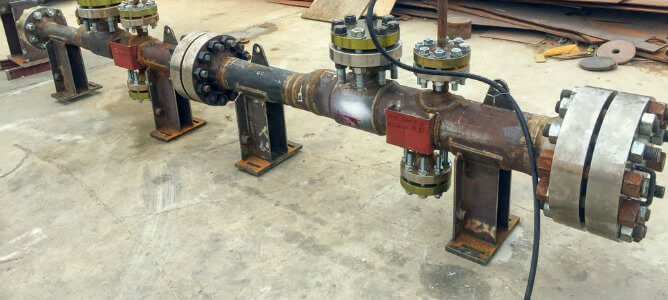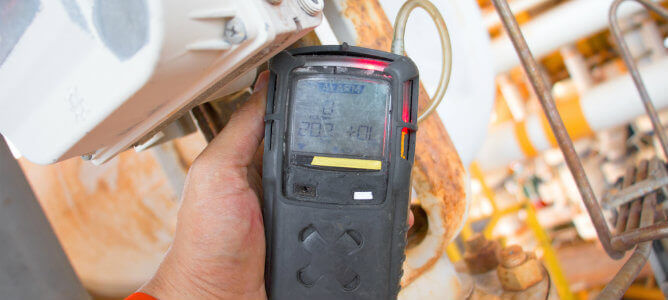
Nitrogen Leak Test Procedure – How to Test for Nitrogen
Nitrogen is utilized within numerous industries for leak testing. While best known is its use in the petroleum industry for pressure testing pipelines and containment vessels, nitrogen is also popular for leak testing in a range of other industries.
There are several advantages to using nitrogen for leak detection. Nitrogen is inert, odorless, and low in moisture content, so it is free from many of the problems associated with using air or water for pressure testing.
In addition, nitrogen is ideal for testing in a variety of locations thanks to portable nitrogen generators. These allow a limitless supply of nitrogen to be conveniently and economically produced wherever it is needed.
What Is Leak Testing?
A nitrogen leak test procedure is performed to verify the integrity of the channels through which it flows. This analytic process is conducted on pipelines, storage vessels, and any other conduit through which an industrial product is conveyed. Leak detection using nitrogen can be done either before the first operational use of equipment or at intervals once during routine operation.
Leak testing allows industrial equipment operators to safely convey their products while minimizing the personnel risk exposure from hazardous chemicals being conveyed through the production channels. Examples include testing for leaks in pipelines, refrigeration systems, checking seals in food processing facilities, and ensuring the functionality of newly-installed fire sprinkler systems.
Why Is Nitrogen Used for Leak Testing?
Nitrogen gas possesses numerous physical qualities that make it uniquely suited to leak testing. It is an inert gas, which is hardly reactive under normal industrial conditions. Gaseous nitrogen also prevents oxidative/corrosive reactions by eliminating water vapor and oxygen from within sensitive equipment.
These reasons make leak testing with nitrogen a superior option to other methods like hydrostatic pressure testing.
How to Conduct a Nitrogen Leak Test
A nitrogen leak test follows an orderly set of steps which varies depending on the nature of the equipment to be checked. The process typically requires channeling a steady stream of gaseous nitrogen through the selected pipes, vessels, or vats under increasing amounts of pressure.
Various mechanical and automated methods can then be used to identify defects within the industrial components being analyzed.
What Is Pressure Testing?
Pressure testing is a critical aspect of pipeline testing before first use as it determines readiness for full operational use. During pressure testing activities, various parameters are analyzed including the following:
- Maximum permissible pipeline capacity
- Leak checking
- Joint fitting stability
- Pressure ratings
- Component reliability
After careful consideration of the above-stated parameters, operators will be able to determine if their newly assembled pipeline will be able to withstand the rigors anticipated when operating at full capacity.
Several pressure tests may be required to find, and correct defects in newly assembled pipeline networks before they can be granted full operational status. NiGen has a pipeline fill calculator available for easy gas volume calculations during pressure tests.
Why Use Nitrogen for Pressure Testing?
The reasons surrounding the use of nitrogen gas as a driver for pressure testing are due to the favorable physical and chemical properties. To begin with, nitrogen is an odorless, colorless, and chemically inert gas which implies non-reactivity with equipment components being subjected to pressure testing.
Further, nitrogen will not expose sensitive equipment to moisture, corrosion, and the accumulation of particulate impurities, Rather, the gaseous nitrogen being used to conduct pressure testing has the added benefit of displacing oxygen, moisture, and particulate contaminants from within the equipment being tested.
Lastly, pressure testing done with nitrogen significantly reduces the risk of spontaneous combustion accidents making the test process a much safer one for all involved personnel.
If you’re in search of pressure vessel or pipeline hydrostatic testing companies, look no further! NiGen has the solutions you need.
How to Pressure Test with Nitrogen
The specifics of leak testing will depend on the vessel or system being tested, but there are general guidelines. To prepare a component of a system for testing, it will need to be isolated from the rest of the system that isn’t to be included in the test. This may require temporarily securing any pressure valves and closing valves that connect the pipe or vessel to upstream or downstream apparatuses.
To begin testing a component, a nitrogen tank or on-site nitrogen generator will be connected to the component. Nitrogen will be released to elevate the pressure within the test component to a low pressure while forcing any air, debris, or other substances out of the component. This will purge the system of contaminants and check for leaks.
Routine pressure testing involves two stages:
- Low-pressure testing
- High-pressure testing
Low-Pressure Testing
This low-pressure test will typically be performed at no more than 25% of the component’s rated operational pressure. The pressure will be held at this level long enough to ensure that the component can successfully hold the pressure without leaking.
If the low-pressure testing is successful, the pressure will then be gradually increased to test if the system will maintain its integrity at higher pressure.
High-Pressure Testing
The pressure will eventually be increased to the rated operational pressure. The actual upper pressure necessary to completed the test will depend on the industry and regulations regarding leak testing.
To locate leaks, a soapy solution can be applied. The pressurized hydrogen escaping will cause the soapy solution to bubble, thus identifying the locations of the leaks. Once any leaks are found at a given pressure level, the component will need to be depressurized and then repaired. Once repairs have been completed, the pressure test can restart from the beginning.
After the pressure test has been completed, the pressure of the nitrogen is lowered. A smaller amount of nitrogen is usually left within the line or vessel to protect it until it is filled with the substance it is designed to hold. The nitrogen continues to protect the interior from the damage or risks that could be caused by exposure to the air.
Often leak tests must be conducted in remote facilities or field locations. For a pipeline maintenance company and other entities that regularly conduct pressure tests in a variety of locations, it is often more economical to purchase portable nitrogen generators.
For companies performing pipeline or vessel purging less often, the best option could be the use of NiGen’s nitrogen generator rentals. NiGen can transport and operate the nitrogen generators whenever they are needed.
Contact NiGen today to learn more about the use of nitrogen generators for pipe and vessel leak testing and purging.

How to Detect Nitrogen Gas
There are several ways to check for nitrogen leaks. During pressure testing, raise the pressure to the required level, then wrap the area being tested in plastic sheeting. Then an oxygen sensor can be inserted through a hole in the plastic. If the oxygen level reaches less than 20%, then a leak can be confirmed.
This method of testing for nitrogen works best when the goal is to pressure check a smaller area like specific flanges or joints following repairs or after the addition of a new connection to an existing system.
Commercial nitrogen (N2) detectors can be purchased. These have been used within the oil and gas industry, and are becoming increasingly common in other industries as the use of nitrogen continues to grow. On the industrial side, nitrogen is used in food processing and packaging, electronics, food, and pharmaceuticals.
Metalworking, refrigeration, and industrial painting facilities use a considerable amount of nitrogen in their processes. In less industrial settings, nitrogen is used within commercial and residential buildings to protect their fire suppression lines and sprinkler heads from the damage that can be caused by moisture. The food services industry is increasingly using liquid nitrogen to freeze food quickly.
Typically, nitrogen gas leak detectors are portable, handheld devices. This allows them to be moved to the site of any suspected leaks. Some nitrogen leak detectors are designed to be set to test for a variety of different gases, allowing the devices to be more versatile.
Nitrogen is inert so leaks present little risk, but the presence of higher nitrogen levels can be used to identify leaks. Finding the precise site of a leak may require isolating and pressure testing individual sections of a system in order to narrow down the location of the leak. After that, one of the nitrogen leak testing methods can be used to find the specific leak location so that repairs can be completed. Following repairs, any areas with seals, valves, or welds should be rechecked to make sure there are no additional leaks.
NiGen Provides On-site Nitrogen Generation Tools for Pressure & Leak Testing
For facilities that require nitrogen on a regular basis, the onsite nitrogen generators are preferred. These produce the desired nitrogen on demand wherever needed without the safety and logistical challenges presented by using tanks of nitrogen. Contact NiGen today to find out which industrial nitrogen generators would be best for your business.
Remember, no matter how and where your company uses nitrogen, NiGen has the solution for you. Contact NiGen’s expert consultants today to learn more about nitrogen systems and rentals.

